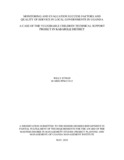| dc.description.abstract | This study assessed contribution of Monitoring and Evaluation (M&E) to Quality of Service under
the Vulnerable Children Technical Support Project in Kabarole. The study sought to; i) Examine
contribution of stakeholder participation in M&E to quality of service; ii) Establish contribution of
financial resources for M&E to quality of service and; iii) Evaluate how institutional uniqueness
affects quality. All the objectives attempted to explain why M&E as a management tool has not
met the expectation of informing quality of service. The study was built on both qualitative and
quantitative approaches and data were obtained using a questionnaire, in-depth interview and
document review. A total number of 120 respondents were targeted but 104 respondents took part.
Findings revealed that participation, financial resource and institutional uniqueness are success
factors for M&E and they contribute to achieving quality. Pearson correlation test showed a weak
positive correlation of 0.286** between participation and quality, a positive correlation of 0.456**
between financial resource and quality and, a correlation of 0.584** between institutional
uniqueness and quality, meaning that stakeholders have not fully participated, funds for M&E have
not been prioritized and characteristics like guidelines and norms have also affected quality. As
supported by literature, attainment of quality can be pledged if desired outcomes are defined,
measured and improved with diligent loyalty to M&E supported by full participation, financial
prioritization and acclimatization to institutional best-fit. It is recommended that; 1) for quality
improvement, stakeholders should fully participate; 2) finances should be prioritized and; 3)
institutions should assimilate M&E into the institutional strategy. While, other factors not
explained by this research should be explored to determine how M&E affects quality of service. | en_US |

